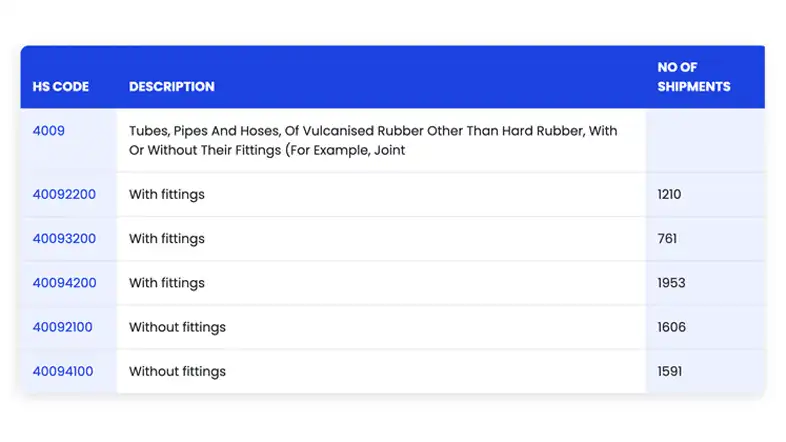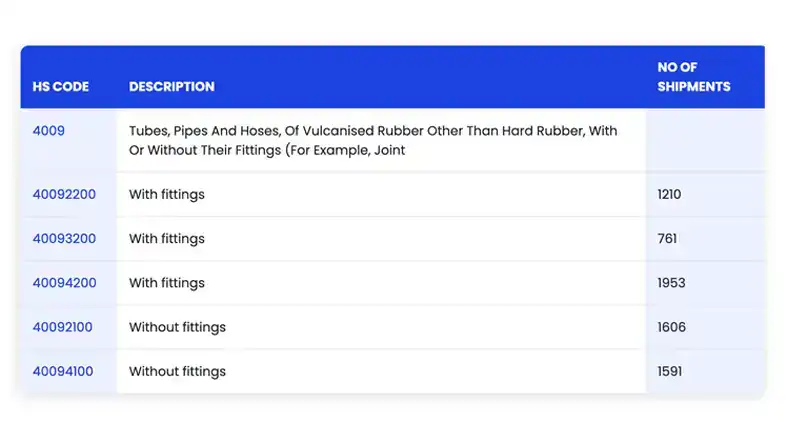If you are involved in international trade and dealing with hydraulic hoses, understanding the HS code is crucial. The HS code is a harmonized system for classifying goods in international trade.
In this comprehensive article, we will delve deep into the hydraulic hose HS code, its significance, and everything you need to know about it.
So, let’s get started.
What is the Hydraulic Hose HS Code?
The hydraulic hose HS code is a unique numeric identifier used to classify hydraulic hoses in international trade. This code is part of the Harmonized System (HS), a standardized system created by the World Customs Organization (WCO) to facilitate the classification of goods across borders. The HS code ensures uniformity in customs tariffs, trade statistics, and regulatory requirements.
Hydraulic Hose HS Code: Import

Hydraulic Hose HS Code: Export

The Structure of Hydraulic Hose HS Code
The HS code is composed of six digits, arranged in a specific order, with each digit carrying specific information about the product. For instance, the first two digits represent the chapter, the next two digits indicate the heading, and the last two digits determine the subheading. This hierarchical structure allows customs authorities to identify the product and its characteristics easily.
Importance of Hydraulic Hose HS Code in International Trade
The hydraulic hose HS code plays a pivotal role in international trade, and its correct classification is crucial for various reasons:
- Customs Clearance: The accurate classification of products using the HS code enables customs authorities to determine the appropriate tariffs, taxes, and duties. This ensures a seamless customs clearance process and helps to prevent any potential delays.
- Trade Statistics: Governments and international organizations use HS codes to gather trade data and generate valuable statistics, helping them make informed policy decisions.
- Regulatory Compliance: Different products may be subject to varying regulations and standards. The HS code assists in identifying these requirements and ensuring compliance with relevant laws.
- Preventing Smuggling and Fraud: By classifying products accurately, the HS code helps prevent smuggling and fraud attempts, safeguarding fair trade practices.
Related terms about hydraulic hose HS code:
- Harmonized System (HS)
- International trade classification
- Import-export regulations
- Customs tariff codes
- World Customs Organization (WCO)
Understanding the Classification of Hydraulic Hose HS Code
Classifying Hydraulic Hoses by Material
Hydraulic hoses can be made from various materials, each having unique properties suited for specific applications. The HS code takes into account the material used to construct the hose, and some common classifications include:
- Rubber Hydraulic Hoses: HS Code – XXXX.XX – Rubber hoses reinforced with textile materials or steel braids.
- Thermoplastic Hydraulic Hoses: HS Code – XXXX.XX – Hoses constructed from thermoplastic materials for high-pressure applications.
- Metal Hydraulic Hoses: HS Code – XXXX.XX – Hoses made from metal, often used in extreme conditions or high temperatures.
Classifying Hydraulic Hoses by End Fittings
The hs code for hydraulic hose fittings also impacts their classification under the HS code. Different fittings serve varying purposes and are suitable for specific hydraulic systems:
- Crimp Fittings: HS Code XXXX. – Hydraulic hoses with permanently attached fittings using a crimping process.
- Reusable Fittings: HS Code XXXX.XX: Hoses with fittings that can be detached and reattached multiple times.
- Flange Fittings: HS Code XXXX. Hoses with flanged ends for secure connections in high-pressure applications
- Push-Lock Fittings: HS Code: XXXX. – Hoses with fittings that provide a quick and easy push-on connection.
Classifying Hydraulic Hoses by Pressure Ratings
The pressure rating of hydraulic hoses is a critical factor in their classification. Different applications require hoses capable of handling specific pressure levels. The HS code distinguishes between various pressure ranges:
- Low-Pressure Hydraulic Hoses: HS Code – XXXX.XX – Hoses suitable for applications with low-pressure requirements
- Medium-Pressure Hydraulic Hoses: HS Code: XXXX. Hoses designed for moderate pressure applications.
- High-Pressure Hydraulic Hoses: HS Code – XXXX.XX – Hoses capable of withstanding high-pressure environments.
Classifying Hydraulic Hoses by Application
Hydraulic hoses are used in a wide range of industries and applications. The HS code considers the intended application of the hose:
- Construction Equipment Hydraulic Hoses: HS Code – XXXX.XX – Hoses used in construction machinery like excavators and loaders.
- Agricultural Equipment Hydraulic Hoses: HS Code – XXXX.XX – Hoses for tractors, harvesters, and other agricultural machinery.
- Industrial Hydraulic Hoses: HS Code – XXXX.XX – Hoses utilized in various industrial processes and machinery.
- Automotive Hydraulic Hoses: HS Code – XXXX.XX – Hoses for automotive braking, power steering, and suspension systems.
Classifying Hydraulic Hoses by Size
The size of hydraulic hoses is a vital consideration in their classification. The HS code accounts for the diameter and length of the hose:
- Small-Diameter Hydraulic Hoses: HS Code – XXXX.XX – Hoses with a small inner diameter, typically used in compact systems.
- Medium-Diameter Hydraulic Hoses: HS Code – XXXX.XX – Hoses with a moderate inner diameter, suitable for various applications.
- Large-Diameter Hydraulic Hoses: HS Code – XXXX.XX – Hoses with a significant inner diameter, commonly used in heavy-duty machinery.
FAQs
What is the HS code for a rubber hydraulic hose with crimp fittings?
The HS code for a rubber hydraulic hose with crimp fittings is XXXX.XX. This code covers hoses reinforced with textile materials or steel braids and permanently attached fittings using a crimping process.
How can I determine the correct HS code for my hydraulic hose?
To determine the correct HS code for your hydraulic hose, you should consider its material, end fittings, pressure rating, application, and size. Consulting the WCO’s official HS code database or seeking assistance from customs experts can also be helpful.
Are there different HS codes for hydraulic hoses used in different industries?
Yes, hydraulic hoses used in different industries may have different HS codes. The classification can vary based on the intended application, material, and other factors specific to each industry.
Can using an incorrect HS code lead to penalties during customs clearance?
Using an incorrect HS code can lead to customs penalties, including delays, fines, and possible shipment confiscation. It is essential to ensure accurate classification to avoid such issues.
Is it necessary to include the HS code on shipping documents?
Yes, including the HS code on shipping documents is crucial for smooth customs clearance. The code allows customs authorities to identify the product and apply the appropriate tariffs and regulations.
Can the HS code be updated if the hydraulic hose design changes?
Yes, if the design or characteristics of the hydraulic hose change significantly, the HS code may need to be updated to reflect the new classification accurately.
Conclusion
Understanding the hydraulic hose HS code is vital for anyone in international trade or dealing with hydraulic hoses. The HS code serves as a universal classification system, simplifying customs procedures, trade statistics, and regulatory compliance.
By considering the material, end fittings, pressure rating, application, and size, one can accurately classify hydraulic hoses for seamless import-export processes.
Remember, using the correct HS code is not just a legal requirement; it ensures smooth trade and contributes to fair and efficient commerce across borders.

